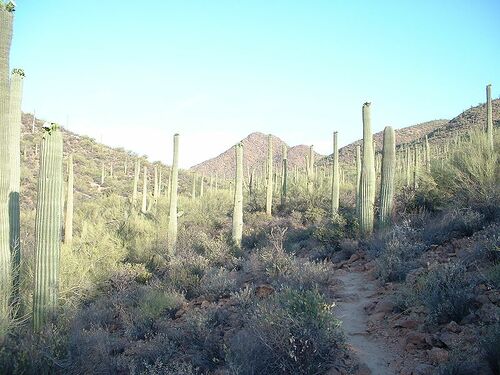| Saguaro | ||||||||||||||||||
|---|---|---|---|---|---|---|---|---|---|---|---|---|---|---|---|---|---|---|
 | ||||||||||||||||||
| Plant Info | ||||||||||||||||||
|
| ||||||||||||||||||
| Scientific classification | ||||||||||||||||||
| ||||||||||||||||||
| Binomial name | ||||||||||||||||||
| Carnegiea gigantea Britton & Rose | ||||||||||||||||||
|
| ||||||||||||||||||
| Synonyms | ||||||||||||||||||
| Cereus giganteus Engelm. |
The Saguaro, pronounced "suh-wah-roh", (Carnegiea gigantea) is a large, tree-sized cactus species in the monotypic genus Carnegiea. It is native to the Sonoran Desert in Arizona, United States and northern Mexico.
The common name of the cactus, saguaro, is a Spanish-language adaptation of a word used by a local aboriginal American nation, the Tohono O'odham, for the plant. Local English speakers pronounce it /səˈwɑɹo/.
Saguaros are slow growing, taking up to 75 years to develop a side arm. The arms themselves are grown to store more water for the Saguaro. Some specimens may live for more than 150 years[1]; the champion saguaro grows in Maricopa County, Arizona and is 13.8 m tall and has a girth of 3.1 m. (It was injured as a result of the Cave Creek Complex fire in June 2005.) In addition to being slow growing, they are also slow to propagate. These two factors argue for the placement of the saguaro on the endangered species list. Harming one in any manner (including cactus plugging) is illegal by state law in Arizona, and when houses or highways are built, special permits must be obtained to move or destroy any saguaro affected.
The night blooming flowers appear April-May and the juicy red fruit matures by late June. Saguaro flowers are self incompatible and require a pollenizer to supply viable pollen. A well-pollinated fruit will contain several thousand tiny seeds, and large quantities of pollen are required for pollination. The major pollinators are bats feeding on the nectar from the night-blooming flowers, which often remain open in the morning. The characteristics of the flower are geared toward pollination by the bats: the nocturnal opening of the flowers, maturation of pollen, and the nectar.
Gila Woodpeckers and the Gilded Flicker create holes for nests in saguaros. Flickers excavate larger holes higher on the stem, penetrating the ribs. Their holes sometimes cause enough damage to cause death and other problems. These woodpeckers create new nest holes each season, rather than reuse the old ones, thus leaving convenient nest holes for a variety of other animals, especially birds such as the Elf Owl.
The ribs of the saguaro are used for construction and other purposes by aboriginal Americans of the region. A fine example can be seen in the roofing of the cloisters of the Mission San Xavier del Bac on the Tohono O'odham lands near Tucson, Arizona. The Seri people of northwestern Mexico used the plant, which they call mojépe, for a number of purposes.
The saguaro blossom is the state flower of Arizona.
Saguaro cactus in AZ, Note the man to the right, he is 5'11.
Snow covered saguaro in Tucson
Sunset in Saguaro National Park
Cristate saguaro found in the Desert Botanical Garden
References
- Benson, L. (1981). The Cacti of Arizona. University of Arizona Press. ISBN 0-8165-0509-8
- Felger, Richard; Mary B. Moser. (1985). People of the desert and sea: ethnobotany of the Seri Indians. Tucson: University of Arizona Press.
External links
- Flora of North America: Carnegiea gigantea
- Jepson Flora Project: Carnegiea gigantea
- Calphotos: Carnegiea gigantea
- USDA Plants Profile: Carnegiea gigantea












